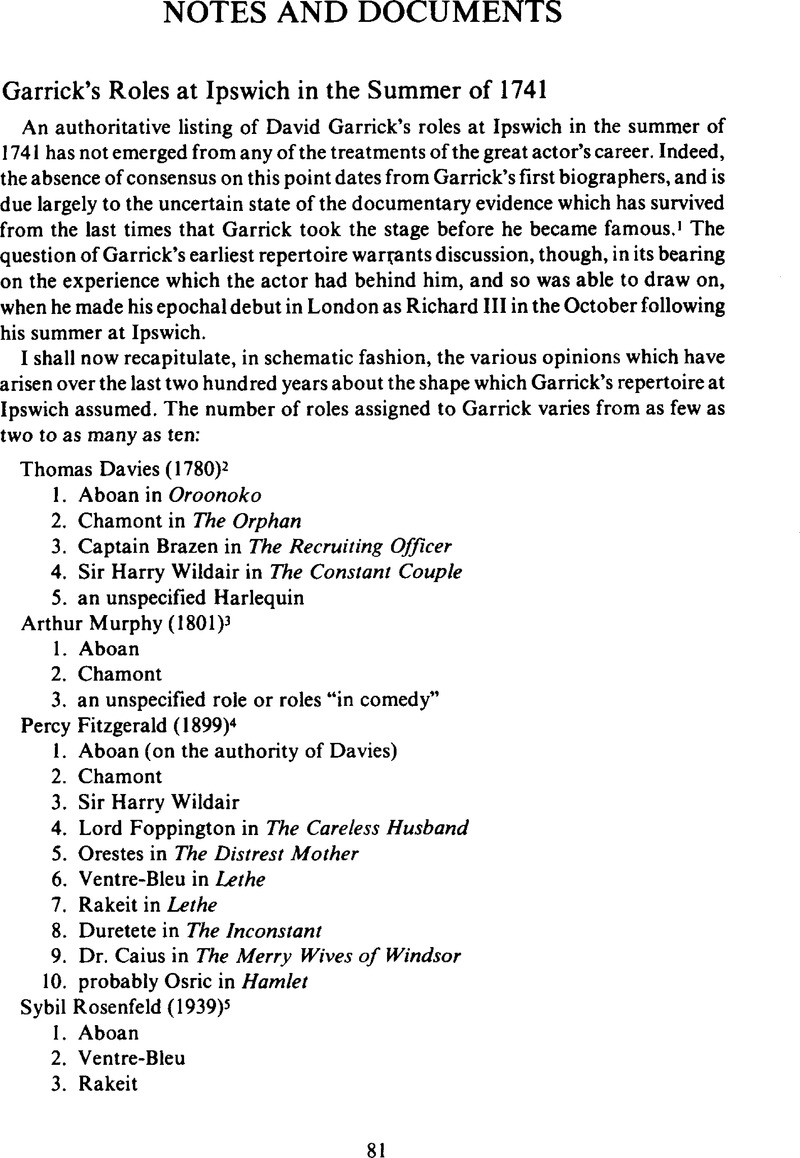No CrossRef data available.
Article contents
Garrick's Roles at Ipswich in the Summer of 1741
Published online by Cambridge University Press: 07 July 2009
Abstract

- Type
- Notes and Documents
- Information
- Copyright
- Copyright © American Society for Theatre Research 1985
References
Notes
1 Among recent historians, Sybil Rosenfeld has described most clearly the fragmentary and elliptical nature of the pertinent evidence at Ipswich, in Strolling Players and Drama in the Provinces (Cambridge: The University Press, 1939), pp. 100–101Google Scholar.
2 Davies, Thomas, Memoirs of the Life of David Garrick, Esq. (London: Printed for the Author, 1780), I, 17–18Google Scholar.
3 Murphy, Arthur, The Life of David Garrick, Esq. (London: Printed for J. Wright, 1801), I, 18–19Google Scholar.
4 Fitzgerald, Percy, The Life of David Garrick, revised edition (London: Simpkin, Marshall, Hamilton, Kent, & Co., Ltd., 1899), pp. 35n.–36Google Scholar.
5 Rosenfeld, pp. 100–01.
6 Oman, Carola, David Garrick (Bungay, Suffolk: Hodder & Stoughton, 1958), pp. 33, 388Google Scholar.
7 Highfill, Philip H., JrBurnim, Kalman A., and Langhans, Edward A., A Biographical Dictionary of Actors and Actresses…in London, 1660–1800, volume 6: Garrick to Gyngell (Carbondale: Southern Illinois University Press, 1978), p. 4Google Scholar.
8 Stone, George Winchester Jr, and Kahrl, George M., David Garrick: A Critical Biography (Carbondale: Southern Illinois University Press, 1979), p. 24Google Scholar.
9 Davies, I, 37–38.
10 See The Letters of David Garrick, ed. Little, David M. and Kahrl, George M. (Cambridge: Harvard University Press, 1963), I, 34Google Scholar.
11 From the composite list, comic roles include Captain Brazen, Sir Harry Wildair, Lord Foppington, Ventre-Bleu, Rakeit, Duretete, Dr. Caius, Osric, and Harlequin. The only tragic roles from this list are Aboan, Chamont, and Orestes. Davies' list of character-types includes seven on the side of comedy, namely Clown, Fop, Fine Gentleman, Man of Humour, Sot, Valet, and Harlequin, and only two from tragedy — Lover and Hero.


